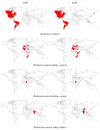Expansion of Tick-Borne Rickettsioses in the World
- PMID: 33266186
- PMCID: PMC7760173
- DOI: 10.3390/microorganisms8121906
Expansion of Tick-Borne Rickettsioses in the World
Abstract
Tick-borne rickettsioses are caused by obligate intracellular bacteria belonging to the spotted fever group of the genus Rickettsia. These infections are among the oldest known diseases transmitted by vectors. In the last three decades there has been a rapid increase in the recognition of this disease complex. This unusual expansion of information was mainly caused by the development of molecular diagnostic techniques that have facilitated the identification of new and previously recognized rickettsiae. A lot of currently known bacteria of the genus Rickettsia have been considered nonpathogenic for years, and moreover, many new species have been identified with unknown pathogenicity. The genus Rickettsia is distributed all over the world. Many Rickettsia species are present on several continents. The geographical distribution of rickettsiae is related to their vectors. New cases of rickettsioses and new locations, where the presence of these bacteria is recognized, are still being identified. The variety and rapid evolution of the distribution and density of ticks and diseases which they transmit shows us the scale of the problem. This review article presents a comparison of the current understanding of the geographic distribution of pathogenic Rickettsia species to that of the beginning of the century.
Keywords: Rickettsiales; Tick-borne diseases; Tick-borne rickettsioses.
Conflict of interest statement
The authors declare no conflict of interest.
Figures









References
-
- Kernif T., Leulmi H., Raoult D., Parola P. Emerging Tick-Borne Bacterial Pathogens. Microbiol. Spectr. 2016;4:1–11. - PubMed
Publication types
LinkOut - more resources
Full Text Sources

